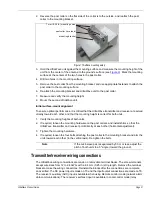
Page 16
UltraWave Product Guide
Figure 11 UltraWave receiver unit
LED # Description
LED # Description
D37
POWER LED ON = DC input Power ON
D6
RXA LED ON = receiving A-side network comm
D35
ALARM LED ON = microwave sensor alarm
D7
TXA LED ON = transmitting A-side network comm
D34
DOOR LED ON = enclosure tamper condition D8
RXB LED ON = receiving B-side network comm
D33
MEMORY LED ON = internal memory fault
D9
TXB LED ON = transmitting B-side network comm
D36
POWER FAIL LED ON = power rail fault
D10
FAULT A LED ON = A-side communication fault
D32
RESERVED
D11
FAULT B LED ON = B-side communication fault
D31
RESERVED
D12
NETWORK POWER LED ON = NIC power ON
D30
UCM ACTIVE LED ON = UCM connected
D13
BOOT LED ON = NIC initialization failure
D24
ALARM LED ON = output 2 activated (sensor
alarm by default/configurable in Local control)
D16
POWER LED ON = input power fault
D25
SUPERVISION LED ON = output 1 activated (supervision alarm by default/configurable in Local control)
Table 5 UltraWave diagnostic activity LEDs
Note
LEDs D6 to D13 also function as a received signal strength
indicator (RSSI) to aid in the final alignment of the UltraWave
system. The tamper switch must be pressed or the shunt must
be installed on T4 to enable the RSSI LED function.
USB port
NIC mounting
T1 expansion
power fault
T3 power
T6 input
relay activity
T4 tamper
S1 tamper
T7 PCB earth
21.5 mm cable
fitted with
D37 - D30
D6 - D13
received
entry ports
compression
glands
ground
connection
switch
bypass
LEDs
header
(for NIC)
output
connections
connection
LED D16
diagnostic &
diagnostic
connect UCM
hardware (X 2)
cover
mounting
standoffs (X 4)
LEDs
signal
strength
indicator
(DO NOT tighten
LEDs
standoffs)
















































